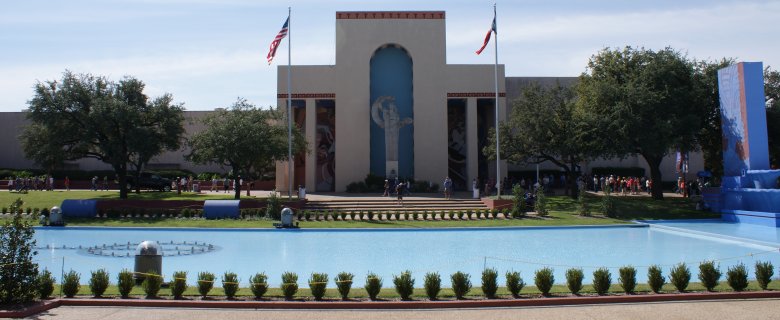Automobile Building
The present Automobile Building, standing on the south side of the Esplanade, was constructed between 1947 and 1948 at a cost of $800,000. It replaced the Centennial Exposition's Electrical and Communications Building and first Automobile Building, which together burned down on February 10, 1942, leaving only Raoul Josset's monumental statues standing. For many decades this structure did not match the architecture of the Centennial Building, being of an entirely different design. As a result, the statues were left out standing away from the building, unlike their sisters across the reflecting pool who were sheltered by their niches within the three giant porticoes. This anomaly was finally corrected in 1985, when matching porticoes were added to the Automobile Building, establishing once again the architectural symmetry of this part of Fair Park. Since it is not generally open to the public (except for the Fair and special events) and contains nothing of interest, casual visitors will have to content themselves with a stroll along the building's 650-foot length to admire Josset's statues. The one nearest the Hall of State represents the United States. This lady wears a shield, emblazoned with an American eagle, upon her breast. As mentioned elsewhere in this guide, Texas became the 28th state of the Union in December 1845 after nearly a decade as an independent country. The center statue represents Mexico. Upon her breast is the Mexican eagle perched atop a cactus. Texas was a province of Mexico from 1821 (when Mexico won independence from Spain) until 1836 when Texas settlers revolted against the despotic rule of Mexican President Antonio Lopez de Santa Anna. It was one hundred years of independence from Mexico, not statehood, which the Centennial Exposition commemorated in 1936. Statuary by Raoul Josset The final statue is France. She wears a fleur-de-lis emblem and in her hand holds a bunch of grapes - symbolic of the wine for which the French are celebrated. France's claim to Texas was short-lived. In 1685, Robert Cavalier, Sieur De La Salle, established a settlement on the coast of what is now Southeast Texas. It was called Fort St. Louis. When the Spanish heard of it they went to investigate but by 1689, when they found it, Fort St. Louis was a ruins, its inhabitants slaughtered by Indians. La Salle himself had killed earlier by some of his own men. (Many Texans are unaware of another interesting link between their state and France: In the late 1890s, when a plant disease threatened to destroy France's grape crop, it was a Texan, internationally-known horticulturalist T. V. Munson of Denison, who came to the rescue with a disease-resistant strain that was successfully grafted on to the French vines - thus saving the entire French wine industry and earning Munson not only the gratitude of the French government but also a Legion of Honor medal. So the next time you enjoy a glass of French wine, see if you can't detect a little taste of Texas in it!) Like the Centennial Building opposite, the original structure on this side of the Esplanade boasted six huge murals inside the alcove of each portal. The artist was Pierre Bourdelle, who created the bas-reliefs that can still be seen on the Centennial Building. Of course when the Electrical and Communications Building burned down in 1942, they were destroyed along with it but fortunately, photographs of the paintings survived. Murals by Pierre Bourdelle (re-creations) In 1999, with funding from the State Fair of Texas, the Friends of Fair Park arranged for Bourdelle's murals to be recreated by artists from the EverGreene Painting Studios of New York City and the work was completed that same year. While in the opinion of this writer they are not as aesthetically pleasing as Ciampaglia's murals (it's the choice of colors that I don't particularly like--too much brick red and dark blue, I think), they are nonetheless bold and powerful depictions of the sort of industries and professions that exhibited on this site in 1936. The murals are named as follows: Beneath United States portico Beneath Mexico portico Beneath France portico Copyright © 1996-2012 by Steven Butler, Ph.D. All rights reserved. |






